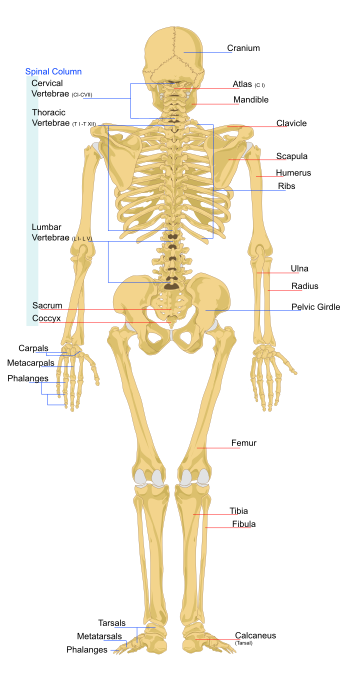Human bones serve as scaffold which support organs, protect organs and anchor muscles like the brain, heart and lungs. Without bones, life is not possible.
which support organs, protect organs and anchor muscles like the brain, heart and lungs. Without bones, life is not possible.
1.) An adult’s skeletal system is about up to 40% of the total body weight and water is half of this weight.
2.) Not all bones are connected. The only human bone in the human body not connected to another is the hyoid. The ‘hyoid’ is .a V-shaped bone located in the neck and serves as the point of attachment for the tongue.
3.) A newborn baby has more than 270 bones while an adult has more than 206 bones. Don’t be surprise because some of the bones fuse together as a person grows old.
4.) Have you figured out what is the biggest bone in your body? Well, the biggest bone in the human body is the ‘femur” which is located in the thigh.
5.) On the other hand, the smallest bones on the human body are the ‘stapes’ bone located in the middle ear.
6.) An average human adult has 206 bones. But as they always say, there are some exemptions. Some people have more pairs of ribs than other. A normal person has 12 pairs while others have 13 pairs making them to have 208 bones in total.
7.) Most people believe that the bones in our body are not white. Actually, they range in color from light brown to beige. If you have already visited a museum, you’ll notice that they are white because they have been cleaned and boiled.
8.) There are 52 bones in our feet and this would simple means that they representing 25% of our 206 bones.
9.) The bones on our hands and feet account for about half of the bones in the human body.
10.) Our big toes have two bones each while the rest have three and they are actually amongst the most important elements within the body as they balance the skeleton and let us move forward when walking. Without our toes we would simply fall over.
and let us move forward when walking. Without our toes we would simply fall over.
11.) The largest bone in the human body is the pelvis which is commonly known as hip bone. Our hip is made of six bones joined firmly together.
12.) As already mentioned, the longest bone is the 'femur ', in the thigh. It makes up almost one quarter of the body's total height.
', in the thigh. It makes up almost one quarter of the body's total height.
13.) The smallest bone in the human body is the 'stirrup'. It is located deep in the ear and it is hardly larger than a grain of rice.
14.) Our Axial Skeleton has 80 bones and is formed by 26Vertebral column with 26 Rib cage and 22 bones and 7 bones.
15.) The nose and the ears do not have bones inside them. The inner supports of the nose and the ears are cartilage or gristle. These are lighter and more flexible than bone.
16.) Bones are harder than cartilage but when a person died the cartilage rots faster than bone. This is why the skulls of skeletons have no nose or ears.
rots faster than bone. This is why the skulls of skeletons have no nose or ears.
17.) Comparatively, men tend to have slightly thicker and longer limbs and digit bones while women tend to have narrower rib cages, smaller teeth, less angular mandibles, less pronounced cranial features such as the brow ridges and external occipital protuberances (the small bump at the back of the skull), and the carrying angle of the forearm is more pronounced in females. Females also tend to have more rounded shoulder blades.
18.) When it comes to supporting weight, the human bone has immense power. A single block of human bone, the size of a matchbox, has the capacity to support a jaw dropping 9 tonnes.
19,) So what’s the hardest bone on human body? According to experts, ‘jawbone” is the hardest bone in the human body. The next time someone suggests you take it on the chin, you might be well advised to take their advice as the jawbone is one of the most durable and hard to break bones in the body.
20.) Male and female pelvises are absolutely different. The female’s hips is flatter, more rounded and proportionally larger to allow the head of a fetus to pass and at the same time, the coccyx  of a female's pelvis is oriented more inferiorly whereas the man's coccyx is usually oriented more anteriorly.
of a female's pelvis is oriented more inferiorly whereas the man's coccyx is usually oriented more anteriorly.
21.) If you want to be healthy, gardening is said to be one of the best exercises for maintaining healthy bones. Happy gardening!
22.) The outsides of our bones are hard and they are generally light and soft inside because they are about 75% water.
23.) The ‘function of the appendicular skeleton’ with 126 bones is formed by the pectoral girdles (4), the upper limbs (60), the pelvic girdle (2), and the lower limbs (60). Their functions are to make locomotion possible and to protect the major organs of locomotion, digestion, excretion, and reproduction.
See also

No comments:
Post a Comment